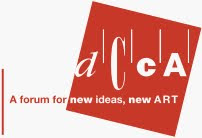
The title of Andrew Wapinski’s exhibition, WASTELAND, suggests a negative connotation toward recent trends of man using material at an alarming rate, yet his work is a beautifully abstracted visceral experience. The paintings are large sublime minimal compositions composed of metal leaf, paint, pigments, and resin resulting in multiple layers. These layers speak toward a linear history of time, yielding in a postmodern result of progress. Within the layers there are subtle grids, due to the rectangles of metal leaf, and various calculated lines etched into the golden surface. Juxtaposed against the strong hard edge linear elements are organic textures, tears, scratches and minor imperfections, all part of Wapinski’s laborious process of treating the surface. The mark making and material manipulation suggests a natural decay alongside a human inflicted environment.

Wapinski experiments with size, scale, and shape with the various works of the Wasteland Series, ranging in format and subtle palette shifts. Wasteland #10 is a vast 7 feet tall by 12 feet long looming experience. The massive panel consists of 3 sections of smaller panels breaking the composition into even thirds. The linear elements layered throughout the picture ranges from subtle grids from squares of gold leaf, angled lines etched into the surface, to organic wrinkles and folds of textures. The angled etched lines connect motifs of silver and cooper leaf squares, seemingly having an abstract mapping conversation.

Wasteland #5 is a smaller rectangle with an aquatic atmosphere. The panel again has golden metal leaf background, but with luscious layers of cool greens and blues washing among haphazard grids and motifs of metal leaf. The work appears to be excavated from the depths of the sea if it were from the lost city of Atlantis.

Wapniski’s most non-traditional format works include a circle and 3 narrow panels. Wasteland #12 is a 66” diameter circle speaking directly toward an idealized perfection of the Italian Renaissance. The surface is much more skin like and feels violent with deep reds and organic tears. Although the work is abstract, one cannot help to make reference to the wounds of Christ or da Vinci’s Vitruvian Man, without the literal use of the figure. The work feels very politically charged and commenting on the violence of man and progress.

Wasteland #13 also feels somewhat violent. The work is comprised of three tall narrow column-like panels with very organic textures and marks among the metal leaf. There are darker black sections to contrast the light reflective gold. The tall panels feel more like wall sculptures than a painting while at the same time reference the history of Barnett Newman’s “zips” in abstract color field painting.
Wapinski is an artist who seems to be very aware of the world around him and manifests the emotion and paradoxical notions of human progress into his abstract works. Wapinski’s WASTELAND is the new triumph of painting for the twenty first century, speaking to the history of painting while transcending the tradition of the medium.
-Ron Longsdorf, April 2010
WASTELAND is on view at the Delaware Center for the Contemporary Arts in Wilmington, DE through April 18th. All images used are courtesy of the artist.




